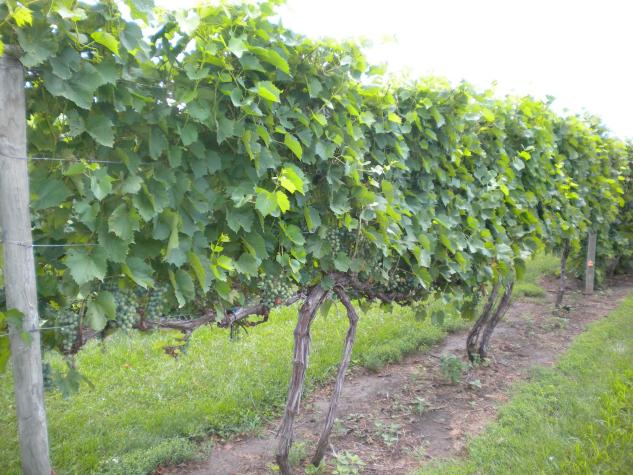BLUE SPRINGS, Mo.–Good fences make for good neighbors, especially if the fence provides fresh, homegrown fruit every year.
“If there is one crop that gardeners have difficulty finding room for in the landscape, it is grapes,” says Marlin Bates, a University of Missouri Extension horticulturist.
Home vineyards often use arbors or pergolas—structures that many homes don’t have. “When grown on these structures, grapevines take up a lot more space than needed and are more difficult to prune,” Bates said. Annual maintenance pruning of grapevines is necessary to balance vegetative and reproductive growth and to keep the vines from spreading out of bounds.
“One way to work grapevines into the landscape plan is to take a page out of the commercial grape grower’s handbook,” he said.
Most commercial grapes are produced on a trellis that trains the growth onto a single vertical plane called a curtain. “The trellis systems used to accomplish this are quite simple and straightforward, requiring only a few well-anchored posts and some high-tensile wire,” he said.
There are two ways to train grapevines to grow into a single curtain: up or down.
High-wire, single-curtain trellis systems position the perennial, woody horizontal growth (called the cordon) about 5 1/2-6 feet off the ground. All growth off the cordon is positioned or combed down toward the ground.
“Because the nature of the vine usually doesn’t allow for the new shoots to go straight down, vines grown on this sort of trellis tend to take up more room as the shoots develop out and down,” Bates said.
The other option is called the vertical shoot position (VSP) trellis. “This system calls for a lower cordon, usually positioned at about 40 inches, and the growth is trained straight up,” he said. Pairs of catch wires capture the developing shoots, holding them in a tight curtain directly above the cordon.
Bates noted that while grapevines should be planted in the spring, fall is the best time to prepare the ground for them. “Soil adjustments and preparation are best done now so that conditions will allow for optimal growth when the vines are planted,” he said.
“Whether you’re considering seedless table grapes, wine grapes, or both, these growing systems can be an attractive and productive addition to the landscape and the neighborhood.”
University of Missouri Extension conducts grape production workshops and field demonstrations throughout the year. To find out about upcoming workshops and demonstrations, contact your local MU Extension center or look online.
For more information, see these MU Extension publications, which are available for free download:
- “Home Fruit Production: Grape Training Systems” (G6090)
- “Home Fruit Production: Grape Culture” (G6085)
Writer: Mildred Carter

